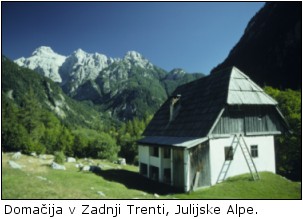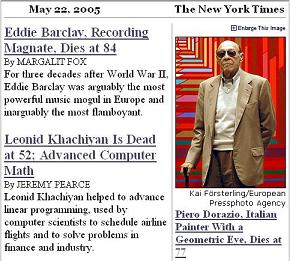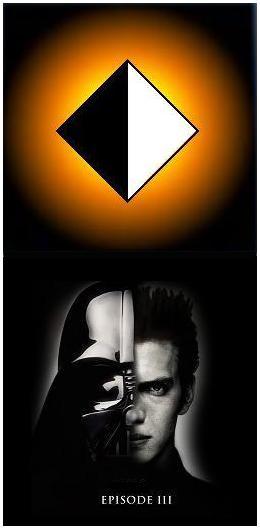From the journal of Steven H. Cullinane...
2005 May 16-31
Tuesday, May 31, 2005
1:06 PM
Subject and Predicates
"A
Chu space is a set X of subjects and a set A of predicates on those
subjects. These stand in a symbiotic relationship in which the nature
of each is determined by the other. Each subject is characterized by
the values the predicates take on it, while each predicate is
characterized by its values on subjects."
-- Vaughan Pratt, Chu Spaces

Click here for Sambin's paper (ps).
It would seem that Pratt and Sambin need to reconcile their similar predicates for the same subject.
For some background on Sambin's approach to the subject, see
Sunday, May 29, 2005
10:00 PM
Just Say Non
"French
opposition to the draft European constitution is being undermined by an
onslaught of state-funded propaganda 'worthy of Fidel Castro,'
according to France's most eurosceptic leader of the Right, Philippe de
Villiers."

de Villiers
-- telegraph.co.uk May 4, 2005

-- telegraph.co.uk May 30, 2005
Saturday, May 28, 2005
12:25 PM
Immoveable Feast
Today is a holiday of the Roman Catholic Church: the feast of St. Germain, Bishop of Paris. St. Germain is now known for the neighborhood that bears his name, home to what is said to be the oldest church in Paris, and a boulevard...
"... I met Joyce who was walking along the Boulevard St.-Germain after
having been to a matinée alone. He liked to listen to the actors,
although he could not see them. He asked me to have a drink with him
and we went to the Deux-Magots...."
-- Ernest Hemingway, A Moveable Feast
Two writers walk into a bar....
Saturday, May 28, 2005
12:00 AM
Well if you want to ride
you gotta ride it like you find it.
Get your ticket at the station
of the Rock Island Line.

Among his films:
Friday, May 27, 2005
12:25 PM
Drama of the Diagonal,
Part Deux
Wednesday's entry The Turning discussed a work by Roger Cooke. Cooke presents a
"fanciful story (based on Plato's dialogue Meno)."
The History of Mathematics is the title of the Cooke book.
Associated Press thought for today:
"History is not, of course, a cookbook offering pretested recipes. It
teaches by analogy, not by maxims. It can illuminate the consequences
of actions in comparable situations, yet each generation must discover
for itself what situations are in fact comparable."
— Henry Kissinger (whose birthday is today)
For Henry Kissinger on his birthday:
a link to Geometry for Jews.
This link suggests a search for material
on the art of Sol LeWitt, which leads to
an article by Barry Cipra,
The "Sol LeWitt" Puzzle:
A Problem in 16 Squares (ps),
a discussion of a 4x4 array
of square linear designs.
Cipra says that
"If you like, there are three symmetry groups
lurking within the LeWitt puzzle: the rotation/reflection group of
order 8, a toroidal group of order 16, and an 'existential'* group of
order 16. The first group is the most obvious. The third, once you
see it, is also obvious."
* Jean-Paul Sartre,
Being and Nothingness,
Philosophical Library, 1956
[reference by Cipra]
For another famous group lurking near, if not within, a 4x4 array, click on Kissinger's birthday link above.
Kissinger's remark (above) on analogy suggests the following analogy to the previous entry's (Drama of the Diagonal) figure:

Logos Alogos II:
Horizon
This figure in turn, together with Cipra's reference to Sartre, suggests the following excerpts (via Amazon.com)--
From Sartre's Being and Nothingness, translated by Hazel E. Barnes, 1993 Washington Square Press reprint edition:
| 1. | on Page 51: |
"He makes himself known to himself from the other side of the world and he looks from the horizon toward himself to recover his inner being. Man is 'a being of distances.'"
|
| 2. | on Page 154: |
| "...
impossible, for the for-itself attained by the realization of the
Possible will make itself be as for-itself--that is, with another horizon of possibilities. Hence the constant disappointment which accompanies repletion, the famous: 'Is it only this?'...." |
| 3. | on Page 155: |
"...
end of the desires. But the possible repletion appears as a
non-positional correlate of the non-thetic self-consciousness on the horizon of the glass-in-the-midst-of-the-world."
|
| 4. | on Page 158: |
| "... it is in time that my possibilities appear on the horizon of the world which they make mine. If, then, human reality is itself apprehended as temporal...." |
| 5. | on Page 180: |
| "...
else time is an illusion and chronology disguises a strictly logical
order of deducibility. If the future is pre-outlined on the horizon of the world, this can be only by a being which is its own future; that is, which is to come...." |
| 6. | on Page 186: |
| "... It appears on the horizon to announce to me what I am from the standpoint of what I shall be." |
| 7. | on Page 332: |
"... the boat or the yacht to be overtaken, and the entire world (spectators, performance, etc.) which is profiled on the horizon. It is on the common ground of this co-existence that the abrupt revelation of my 'being-unto-death'...."
|
| 8. | on Page 359: |
"... eyes as objects which manifest the look. The Other can not even be the object aimed at emptily at the horizon of my being for the Other."
|
| 9. | on Page 392: |
"...
defending and against which he was leaning as against a wail, suddenly
opens fan-wise and becomes the foreground, the welcoming horizon toward which he is fleeing for refuge."
|
| 10. | on Page 502: |
| "... desires her in so far as this sleep appears on the ground of consciousness. Consciousness therefore remains always at the horizon of the desired body; it makes the meaning and the unity of the body." |
| 11. | on Page 506: |
"...
itself body in order to appropriate the Other's body apprehended as an
organic totality in situation with consciousness on the horizon-- what then is the meaning of desire?"
|
| 12. | on Page 661: |
| "I was already outlining an interpretation of his reply; I transported myself already to the four corners of the horizon, ready to return from there to Pierre in order to understand him." |
| 13. | on Page 754: |
| "Thus to the extent that I appear to myself as creating objects by the sole relation of appropriation, these objects are myself.
The pen and the pipe, the clothing, the desk, the house-- are myself.
The totality of my possessions reflects the totality of my being. I am
what I have. It is I myself which I touch in this cup, in this
trinket. This mountain which I climb is myself to the extent that I
conquer it; and when I am at its summit, which I have 'achieved' at the
cost of this same effort, when I attain this magnificent view of the
valley and the surrounding peaks, then I am the view; the panorama is myself dilated to the horizon, for it exists only through me, only for me." |
Illustration of the last horizon remark: 

From CIPRA – Slovenia,
the Institute for the
Protection of the Alps |
For more on the horizon, being, and nothingness, see
Thursday, May 26, 2005
4:23 PM
Drama of the Diagonal
"The beautiful in mathematics
resides in contradiction.
Incommensurability, logoi alogoi, was
the first splendor in mathematics."
-- Simone Weil, Oeuvres Choisies,
éd. Quarto , Gallimard, 1999, p. 100

Logos Alogos
by S. H. Cullinane
"To a mathematician, mathematical entities have their own existence,
they habitate spaces created by their intention. They do things,
things happen to them, they relate to one another. We can imagine on
their behalf all sorts of stories, providing they don't contradict what
we know of them. The drama of the diagonal, of the square..."
-- Dennis Guedj, abstract of "The Drama of Mathematics," a talk to be given this July at the Mykonos conference on mathematics and narrative.
For the drama of the diagonal of the square, see
Thursday, May 26, 2005
4:00 AM
The Changing
The previous entry dealt with a transformation
of the diamond figure from Plato's Meno
into a visual proof of the Pythagorean theorem:
Here is a transformation of Plato's diamond
into the "gyronny" pattern of heraldry:
Wednesday, May 25, 2005
2:22 PM
The Turning
Readers who have an Amazon.com account may view book pages relevant to the previous entry. See page 77 of The Way We Think,
by Fauconnier and Turner (Amazon search term = Meno). This page
discusses both the Pythagorean theorem and Plato's diamond figure in
the Meno, but fails to "blend" these two topics. See also page 53 of The History of Mathematics,
by Roger Cooke (first edition), where these two topics are in fact
blended (Amazon search term = Pythagorean). The illustration below is
drawn from the Cooke book.

Cooke demonstrates how the Pythagorean theorem might have been derived by "blending" Plato's diamond (left) with the idea of moving the diamond's corners (right).
The previous entry dealt with a conference on mathematics and
narrative. Above is an example I like of mathematics.... Here is an
example I like of narrative:
Kate felt quite dizzy. She didn't know exactly what it was
that had just happened, but she felt pretty damn certain that
it was the sort of experience that her mother would not have
approved of on a first date.
"Is this all part of what we have to do to go to Asgard?"
she said. "Or are you just fooling around?"
"We will go to Asgard...now," he said.
At that moment he raised his hand as if to pluck an apple,
but instead of plucking he made a tiny, sharp turning movement.
The effect was as if he had twisted the entire world through a
billionth part of a billionth part of a degree. Everything
shifted, was for a moment minutely out of focus, and then
snapped back again as a suddenly different world.
-- Douglas Adams, The Long Dark Tea-Time of the Soul
And here is a blend of the concepts "Asgard" and "conference":
"Asgard
During the Interuniverse Society conference,
a bridge was opened to Valhalla...."
Bifrost
In Norse myth, the rainbow bridge
that connected Earth to Asgard,
home of the gods. It was extended
to Tellus Tertius during the
Interuniverse Society conference"
-- From A Heinlein Concordance

-- Front page picture from a
local morning newspaper published
today, Wednesday, May 25, 2005
As George Balanchine once asked,
"How much story do you want?"
Wednesday, May 25, 2005
12:00 AM
"Poetry is a satisfying of
the desire for resemblance....
If resemblance is described as
a partial similarity between
two dissimilar things,
it complements and reinforces
that which the two dissimilar things
have in common.
It makes it brilliant."
-- Wallace Stevens,
"Three Academic Pieces" in
The Necessary Angel (1951)
Two dissimilar things:
1. A talk to be given at a conference on "Mathematics and Narrative" in Mykonos in July:
Mark Turner,
"The Role of Narrative Imagining in Blended Mathematical Concepts" --
Abstract:
"The Way We Think
(Gilles Fauconnier and Mark Turner; Basic Books, 2002) presents a
theory of conceptual integration, or "blending," as a basic mental
operation. See http://blending.stanford.edu. This talk will explore some ways in which narrative imagining plays a role in blended mathematical concepts."
2. An application of the "conceptual blending" of Fauconnier and Turner to some journal entries of 2004: Cognitive Blending and the Two Cultures.
Tuesday, May 24, 2005
2:00 PM
Final Arrangements, continued:
Two Poles
From today's New York Times:

From erraticimpact.com on Paul Ricoeur:
"Ricoeur reserves his greatest admiration for
the narratologist Algirdas-Julien Greimas.
[See below.]
Ricoeur also explores the relationship
between the philosophical and religious
domains, attempting to reconcile
the two poles in his thought."
From today's NYT obituary of Sol Stetin:
"Mr. Stetin, who emigrated from Poland at the age of 10 and dropped out
of high school in the ninth grade, was fond of saying he got his
education in the labor movement." | |
"... it is not in isolation that the rhetorical power of such
oppositions resides, but in their articulation in relation to other
oppositions. In Aristotle's Physics the four elements of earth, air, fire and water
were said to be opposed in pairs. For more than two thousand years
oppositional patterns based on these four elements were widely accepted
as the fundamental structure underlying surface reality....
 The structuralist semiotician Algirdas Greimas introduced the semiotic square (which he adapted from the 'logical square' of scholastic philosophy) as a means of analysing paired concepts more fully...."
The structuralist semiotician Algirdas Greimas introduced the semiotic square (which he adapted from the 'logical square' of scholastic philosophy) as a means of analysing paired concepts more fully...."
-- Daniel Chandler, Semiotics for Beginners
Monday, May 23, 2005
1:00 PM
"I've recently had it brought to my attention that the current accepted
primary colors are magenta, cyan, and yellow. I teach elementary art
and I'm wondering if I really need to point out that fact or if I
should continue referring to the primary colors the way I always have
-- red, yellow, and blue! Anyone have an opinion?"
"There is a fundamental difference between color and pigment. Color represents energy radiated.... Pigments, as opposed to colors, represent energy that is not absorbed...."
Another good background page
for elementary color education:
Colored Shadow Explorations.
A good starting point for
non-elementary education:
The "Color" category in Wikipedia.
Further background:
From "The Relations between
Poetry and Painting," by Wallace Stevens:
"The
theory of poetry, that is to say, the total of the theories of poetry,
often seems to become in time a mystical theology or, more simply, a
mystique. The reason for this must by now be clear. The reason is the
same reason why the pictures in a museum of modern art often seem to
become in time a mystical aesthetic, a prodigious search of appearance,
as if to find a way of saying and of establishing that all things,
whether below or above appearance, are one and that it is only through
reality, in which they are reflected or, it may be, joined together,
that we can reach them. Under such stress, reality changes from
substance to subtlety, a subtlety in which it was natural for Cézanne
to say: 'I see planes bestriding each other and sometimes straight
lines seem to me to fall' or 'Planes in color. . . . The colored area
where shimmer the souls of the planes, in the blaze of the kindled
prism, the meeting of planes in the sunlight.' The conversion of our Lumpenwelt
went far beyond this. It was from the point of view of another subtlety
that Klee could write: 'But he is one chosen that today comes near to
the secret places where original law fosters all evolution. And what
artist would not establish himself there where the organic center of
all movement in time and space—which he calls the mind or heart of
creation— determines every function.' Conceding that this sounds a bit
like sacerdotal jargon, that is not too much to allow to those that
have helped to create a new reality, a modern reality, since what has
been created is nothing less."
From Bester's The Deceivers (1981):
He stripped, went to his Japanese bed in the monk's cell, thrashed, swore, and slept at last, dreaming
crazed p a t t e r n s
a t t e r n s
t t e r n s
t e r n s
e r n s
r n s
n s
s |
Monday, May 23, 2005
2:56 AM
Final Arrangements
continued:

Elements:

PIERO DORAZIO
(1927 - 2005) |

Aquatint, 1982
Plate 9.5 x 9 cm | Sheet 24 x 16 cm
99 copies signed and numbered
from 1/99 to 99/99,
15 from I/XV to XV/XV
Copy 11/99
Printed by Renzo Romero, Rome.
This artwork accompanies the book
Staras by Guido Ballo,
edition Galleria Rizzardi, Milan (1982).
-- Edizioni l'Obliquo, Galleria di Grafica
|
"Elegant." -- The Daily Telegraph
Sunday, May 22, 2005
4:09 PM
The Diamond in the Labyrinth
From the labyrinth of Solitude:
- An Invariant Feast
- Columbia News obituary of Robert D. Cumming
- Solitude
(Phenomenology and Deconstruction, Vol 4
by Robert Denoon Cumming)
On page 13 of Solitude --
From Heidegger's "Letter on Humanism" --
"... so long as philosophy merely busies itself with continually
obstructing the possibility of admission to the subject of thinking--
that is, the truth of being-- it escapes the danger of ever being
broken against the hardness of that subject. Thus 'philosophizing'
about the shattering is separated by an abyss from a thinking that is
shattered."
This suggests a search for
"Heidegger" + "diamond," which yields --
- The Diamond at the End of Time,
which leads to
- Orson Welles Interviews Jilly Dybka,
which leads to
- Poetry Hut Blog,
which leads to
- Fair Territory, by Jilly Dybka,
which contains the following --
- The Quickening
I hold my breath, the plane’s
wheels under me
still suspended in the minutes after
takeoff, when the planet’s brute gravity
statistically can cause a disaster.
We are flying low enough that I scan
civilization in miniature.
Blue pill swimming pools, and
roadways that fan
out like ribbons in the wind. On the sure
crust, too, a baseball diamond.
Young boys race
across the tilted surface, mute and small,
kicking up red dust. First base, Second base,
Third Base, Home. We ascend into nightfall
and beneath the broken stars one kid bunts.
I remember I was a rookie once.
- From yesterday's online New York Times:

Nine is a Vine.
Sunday, May 22, 2005
12:25 PM
The Shining
of Friday the 13th
From Margalit Fox in today's New York Times:
"Eddie
Barclay, who for three decades after World War II was arguably the most
powerful music mogul in Europe and inarguably the most flamboyant, died
on [Friday] May 13 in Paris. He was 84....
... Mr. Barclay was best known for three things: popularizing American
jazz in France in the postwar years; keeping the traditional French
chanson alive into the age of rock 'n' roll; and presiding over parties
so lavish that they were considered just the tiniest bit excessive even
by the standards of the French Riviera....
Among the guests at some of his glittering parties... Jack Nicholson...."

Related material:
"Joyce’s confidant in Zurich in 1918, Frank Budgen, luckily for us described the process of writing Ulysses.... 'Not
Bloom, not Stephen is here the principal personage, but Dublin itself…
All towns are labyrinths…' While working... Joyce bought a game called
Labyrinth, which he played every evening for a time with his daughter,
Lucia. From this game he cataloged the six main errors of judgment into
which one might fall in seeking a way out of a maze."
-- quoted by Bruce Graham from The Creators by Daniel Boorstin
"We'll always have Paris."
-- An Invariant Feast, Log24, Sept. 6, 2004
Saturday, May 21, 2005
10:29 PM
Icarus at Boardwalk
"As in Monopoly, the fortunes of
the Boardwalk depend on the roll of
the dice. It's the final stop on the
game board, the crown jewel...."
-- Eileen Smith, Sept. 6, 2004
A link from Log24 last night:
A Throw of the Dice:
The Life of Stéphane Mallarmé
From Log24 on Aug. 29, 2003:
Saturday, May 21, 2005
12:35 PM
Saturday, May 21, 2005
12:16 AM
From a March 10, 2004, entry:
"Language was no more than a collection of meaningless conventional
signs, and life could absurdly end at any moment. [Mallarmé] became aware, in Millan's* words, 'of the extremely fine line
separating absence and presence, being and nothingness, life and death, which later ... he could place at the very centre of his work and make the cornerstone of his personal philosophy and his mature poetics.' "
-- John Simon, Squaring the Circle
* A Throw of the Dice: The Life of Stéphane Mallarmé, by Gordon Millan
For those who prefer
art that is more lurid:

(Photo in lower half
from Cinetribulations)
Related material:
Friday, May 20, 2005
1:20 PM
The Shining of Apollo
"Plato's most significant passage may be found in Phaedrus 265b:
'And we made four divisions of the divine madness, ascribing them to
four gods, saying that prophecy was inspired by Apollo, the mystic
madness by Dionysos, the poetic by the Muses, and the madness of love
[...] by Aphrodite and Eros' (trans. by H.N. Fowler, in the Loeb
Classical Library)."
-- Saverio Marchignoli, note on section 20, paragraphs 115-119, of the Discourse on the Dignity of Man (Oratio de hominis dignitate) (1486) by Pico della Mirandola, considered the "Manifesto of the Renaissance."
Related material:
A Mass for Lucero,
The Shining of May 29,
Shining Forth,
Sermon for St. Patrick's Day, and the phrase
Diamond Struck by the Sun.
Thursday, May 19, 2005
10:10 AM
Shining Through
"Schon
in der Antike gab es zwei Definitionen der Schönheit, die in einem
gewissen Gegensatz zueinander standen.... Die eine bezeichnet die
Schönheit als die richtige Übereinstimmung der Teile miteinander und
mit dem Ganzen. Die andere, auf Plotin zurückgehend, ohne jede
Bezugnahme auf Teile, bezeichnet sie als das Durchleuchten des ewigen
Glanzes des 'Einen' durch die materielle Erscheinung."
-- Werner Heisenberg

"Heisenberg
sets down his glass. 'Perhaps I may remind you of the second definition
of beauty, which stems from Plotinus: "Beauty is the translucence,
through the material phenomenon, of the eternal splendor of the
One."'....
It's that translucence, that light shining through,
that brings us to tears, wherever we find it.... As Sidney Bechet put
it, 'You've got to be in the sun to feel the sun.'"
-- Matt Glaser, Satchmo, the Philosopher,
Village Voice Jazz Supplement,
June 6-12, 2001
Wednesday, May 18, 2005
11:07 PM
"Beauty is the proper conformity
of the parts to one another
and to the whole."
— Werner Heisenberg,
"Die Bedeutung des Schönen
in der exakten Naturwissenschaft,"
address delivered to the
Bavarian Academy of Fine Arts,
Munich, 9 Oct. 1970, reprinted in
Heisenberg's Across the Frontiers,
translated by Peter Heath,
Harper & Row, 1974
Related material:

The Eightfold Cube
Wednesday, May 18, 2005
4:00 PM
Lindbergh's Eden
"The Garden of Eden is behind us
and there is no road back to innocence;
we can only go forward."
— Anne Morrow Lindbergh,
Earth Shine, p. xii















 The structuralist semiotician Algirdas Greimas introduced the semiotic square (which he adapted from the 'logical square' of scholastic philosophy) as a means of analysing paired concepts more fully...."
The structuralist semiotician Algirdas Greimas introduced the semiotic square (which he adapted from the 'logical square' of scholastic philosophy) as a means of analysing paired concepts more fully...."










